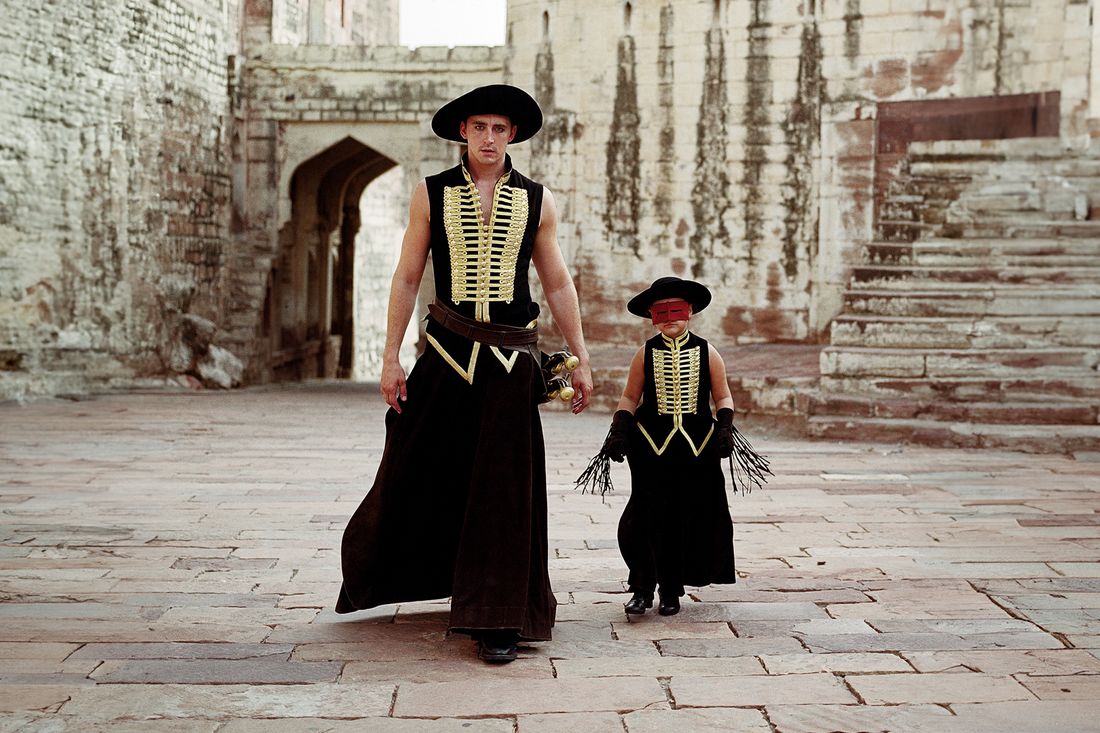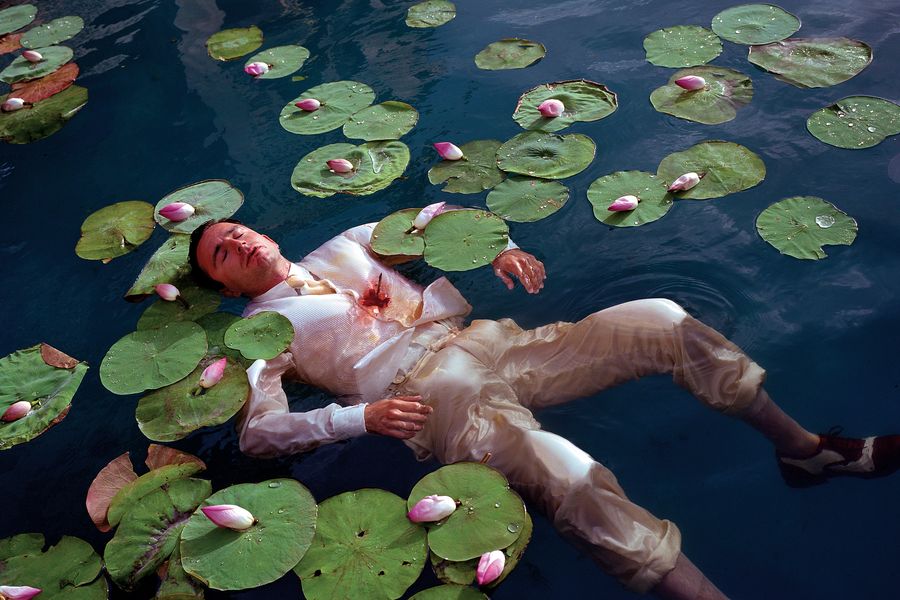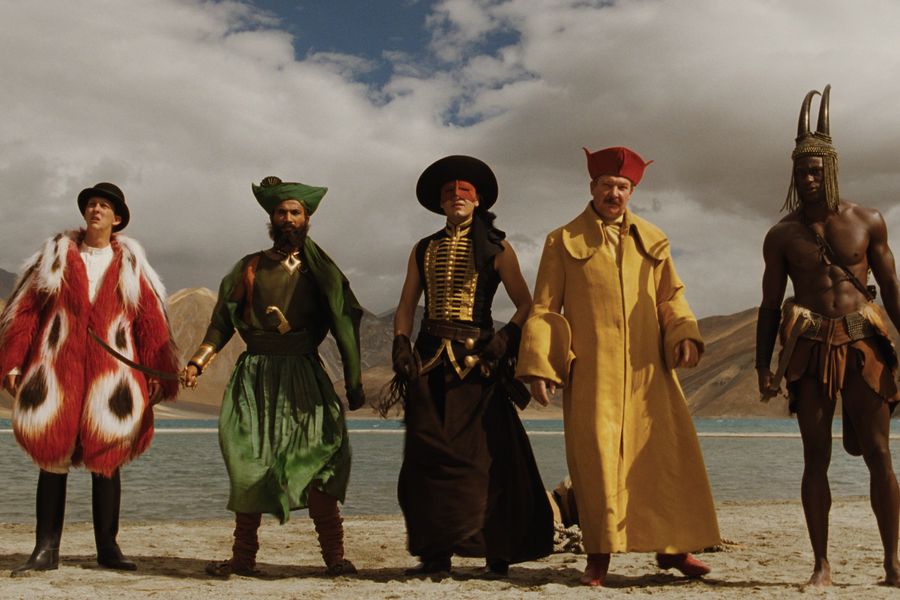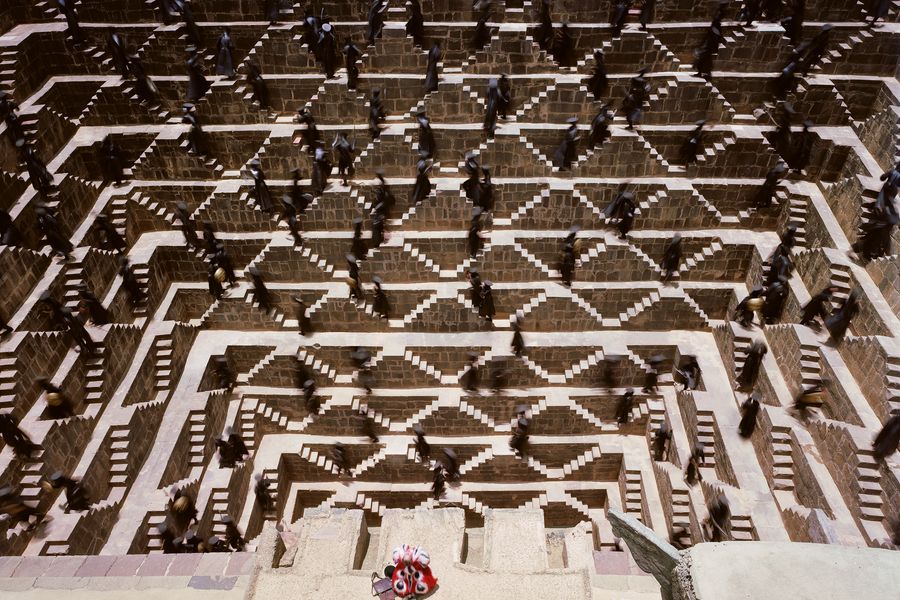
This article was originally published on September 27, 2024. We are recirculating it now that The Fall is back in theaters.
It took 20 years for Tarsem Singh to figure out why he made The Fall, and when that insight arrived, it came from his childhood friends. After his family moved to Iran when Singh (who goes by only “Tarsem” professionally) was three, he and his brother were sent to boarding school in the Himalayas. For nine months of the year, Singh was surrounded by the majestic splendor of the mountain range and the natural landscape; for the three winter months when he’d return to Iran, he would soak up television, mostly American films dubbed into Persian, a language he didn’t yet speak well. (He now speaks it fluidly and enthusiastically.) Singh didn’t understand what the actors were saying, and the movies were stripped of laugh tracks, so he was unsure of tone, too. But there was a rhythm to the storytelling that appealed to him, and that he mimicked when he’d recount the movies to his classmates. Just not always accurately.
“I would come back and tell the stories, and they were whatever I wanted them to be,” Singh says. “I used to tell them about Get Smart. He was just a really cool spy to me that could call on his phone, which was in his shoe. And they were thinking, ‘That was supposed to be a comedy, you idiot.’ My friends, years later, said, ‘Oh, The Fall’s like that, because the stories that you told were completely fucking bizarrely different then.’”
Singh’s 2006 cult classic, the long-awaited 4K restoration of which began streaming Friday on MUBI, is more intentional in its genre experimentation. Loosely based on the 1981 Bulgarian film Yo Ho Ho, it’s set in a Los Angeles hospital in the 1920s and centers the unlikely friendship between patients Alexandria (eight-year-old Catinca Untaru), a young Romanian immigrant nursing a broken arm and grieving her father, and Roy (Lee Pace, before his Pushing Daisies breakout), a stuntman recovering from a fall gone wrong and a devastating breakup. Alexandria immediately bonds with Roy, in whom she sees a father figure, while Roy is planning his death by suicide, and manipulates Alexandria into stealing the morphine pills he’ll need to do it. To convince her, he tells her a story about a group of bandits traveling the world to battle a dastardly governor, with the characters played by people Alexandria sees around the hospital. Reality and fiction blend on screen, with Roy’s narration and Alexandria’s imaginings coming together into a mesmeric story about mythmaking, misunderstanding, and creativity as a reciprocal process.
When the film premiered at TIFF, critics were divided; Roger Ebert was (and remained) a strong defender, but there were vociferous pans, too. It took two years for the film to get picked up by Roadside Pictures for a limited theatrical run, and after The Fall’s initial release on physical media, it seemed to disappear. It wasn’t streaming or available for digital rental, so second-hand DVDs and Blu-rays regularly went for hundreds of dollars online and pirated copies passed through cinephile circles. When MUBI announced in July that they had acquired Singh’s 4K remaster, it felt like a movie was coming back from the dead.
In this gorgeously colored, crisply rendered version, The Fall practically vibrates off the screen. (MUBI confirms that a physical release of the film is in the works for 2025.) The Fall was filmed over four years, with various production singularities that have since become infamous among the film’s devoted fanbase. Dialogue and story developments were written on the fly, like the scene where Alexandria brings Roy only three morphine pills — inspired by Untaru misreading the letter “E” in “morphine” as the number three — and Roy and Alexandria having different ethnic definitions of the term “Indian.” Singh credits Pace with helping flesh out the film’s theme about the two-way nature of storytelling, and he’s full of recollections and anecdotes.
Talk to me about the timeline for this 4K restoration project. What inspired you to do this?
Last year I took Dear Jassi to Toronto, and I was kind of mobbed by people. Anybody who would interview me about Dear Jassi, they would be like, “Why can’t we see The Fall?” And I would go, “Yeah. Why can’t I answer that?” I was like, “Where were you when we were trying to get people to take this movie for fucking free?” Nobody wanted it. I had to spend another two years working to get it out into like 10, 12 theaters so that people would remember it for the future, and not remember it as a small film that they saw on their computer. I realized that there was this whole critical mass that had evolved around it, and everybody wanted it. A film that I really loved, Jonathan Glazer’s Birth, was with my film at 50 percent on the Tomatometer. That means people will love it and will kill for it, and then there are people who think it’s shit. Unfortunately for me now, The Fall has started going up on the Tomatometer because a lot of the old critics fortunately have died — I hope horribly. And the newer generation that saw it, they go, “Actually, this was nowhere near as bad as advertised.”
The third festival we were in, in Saudi Arabia, I met Efe Cakarel from MUBI. He literally said, “I love the film.” I said, “It’s yours. You just tell me what it will take to get eyeballs on it. If streaming goes away after some years, I want to make sure it is available on Apple or anything like that.” I didn’t mind where people were getting the movie, but they were downloading it from these horrible sites in China and in Russia. When MUBI came along, it was a match made in heaven because I could see that that team really liked it. Then the problem was that the 4K that I knew was around could not be found. When we started looking for it, there was just a whole bunch of corrupted materials. So we did another version. There was a shot I remember of Catinca that was out of focus. I had to kill myself trying not to use it, but I did use it. And now when I see it on the big screen, I go [gnashes his teeth, grimaces]. She’s not even moving. She’s lying in the bed, and her eyes are soft. It’s the last thing I want to ever notice. Nobody even blinks looking at that shot. They don’t even see it. And all I can think is, It’s big and massive and it’s soft. And I just get angry.
Before the MUBI deal, did you explore streaming it on another service?I’m not particularly Internet savvy. [Laughs.] Like I say, if it wasn’t for porn and chess, I would have never discovered the Internet. I only watch stuff on Apple TV. I was just telling my lawyer, “I want people to be able to buy it if they want.” She said, “Oh, you want streaming?” And I was just like, “Whatever that is, do it.” She had said, “I’ll approach Criterion.” I wouldn’t say they said no. They just never, never, never responded from any channel that I went through.
You said something that was important to you about going with MUBI was that the film could be purchased digitally. Are you planning another physical release?
We are finishing that. I want there to be, because otherwise people will keep complaining that they bought it for $300 on eBay. That was the reason I went for this. We are producing it on Blu-ray. I will follow up with them, because that was the one of the main things for me, getting it streaming and then physically making it available for people. It’s got the kind of following that likes having it around.
There are some changes in this version, including two restored deleted scenes. Why were those deleted, and why did you decide to add them back in?
After Toronto, everybody told me, “You’ve got to make a slight change in the film, so you can say it wasn’t the film that the critics had seen.” There is one scene that I should have never touched. I just arbitrarily said, “I need to get rid of two scenes, because I need to lose a minute and a half.” I’ve been an atheist since I was in my preteens. The priest character, he’s the guy who Alexandria throws the oranges at in real life, and then later on, he comes out as the villain. In between, there was a scene which helps make more clear who’s really the author of the story: the storyteller or the person who’s listening to it? Roy starts to introduce the priest as a bad guy, and Alexandria goes, “Whoa! But the priest is a good guy!” And he goes, “Uh … yeah.” The priest has a stick in his hand, and he’s walking toward the child, and Roy goes, “The stick was for … a snake!” And the line of the priest shouting and saying, “Darwin!” because that’s his arch-enemy, evolution. [Laughs.] I always loved that scene, and when I was losing it, I said, “Let’s get it done. I’ve gone bankrupt almost twice. Let’s take it out.” That was it for me. But this time, I looked at it, and I said, “No, that scene needed to be in there.”
The other scene I could live without showed the landscape in the Himalayas. I took the biggest crane we could get up there, and did this crane move. I took it out because needed to [snaps fingers to as if to say “hurry up”]. Nico Soultanakis and I had written a shooting script. That’s all I wanted to do. But Dan Gilroy came in and he made a really good point. He said, “There’s a way you can make this more commercial. It’s the Hitchcock line. You can have a really boring conversation, as long as in the beginning, you cut under the table and there’s a bomb. And now, whenever these people talk, your attention is there. And Dan’s thing was, “Roy’s got an agenda. He’s trying to commit suicide. Introduce that earlier, and there’ll be a lot more forgiven.” And I thought about it, and I said, “No.” First, I want it to be about a meander. That’s what people complain about, that the fucking thing goes all over the place. I say, “Yes. Have you tried talking to a five-year-old? And you need something from the five-year-old?” It’s like pulling hen’s teeth. So for me, I said, “No. It should look like the film is about the meander, and then you realize, actually, it’s got a direction.” He said, “That all’s fair,” and then Dan left. But it was a wonderful point that he made. That particular scene, the long crane one, I just thought, Take that out, maybe I can help a little bit by getting to his agenda earlier. But now, the kind of people that will go to see the film, they already are expecting something unusual.
That crane shot is beautiful. I had wanted to ask you about that scene.
It was a 360. It’s when Luigi’s on the horse and the Mystic starts eating the map. In the beginning of that now, there is a massive crane move before you arrive there. Then there’s the 180 that goes down into the greens. But I brought the biggest crane in the world to this inhospitable place in the Himalayas. I said, “I got to do another shot,” and I did that shot. I didn’t know where the story was going to go, but I loved the landscape. I just wrote the dialogue out there, where the Mystic says, “Follow me to the greener pastures!” When he goes down and I cut to Bali, and it’s the greenest valley you can imagine.
And the film now opens with a title card, “Los Angeles, Once Upon a Time.”
This was the original title. I wanted to make sure you understand this is not the story that the guy told. It’s the child’s perspective, remembering it later on in life. I thought about introducing an old person, and then you realize that they’re remembering their story. Initially when we made the film, I had the whole black-and-white sequence, then tried having an old woman speaking, and it just looked so tacky up front that you lost me before the movie started. I thought, People can see that it’s a child’s perspective. I’ll just put ‘once upon a time.’ I wanted to write “Hollywood, once upon a time,” but then I thought, “Does it not work?” Because English is not really my first language. I was always trying to say, this is somebody remembering the story from back then. It’s a little girl. I needed that license, and I lost the license with a lot of the audience by not having that voiceover up front and not getting the title right. This is a compromise that hopefully helps.
What I don’t want to happen, and what could have made me money initially, is to dub this film. Categorically, no matter how much money they offer me, nobody is allowed to dub this film. The dialogue is how it is. If you can’t hear the nuances of a person who is actually trying their best to communicate with you, but struggles because it’s not her first language — that’s what the movie’s about. If you’re gonna dub it, I can’t trust that.
Have you stayed in touch with any of the actors from the film, or got in touch to tell them about the streaming release?
I just yesterday wrote to Lee Pace. I do keep in touch with Lee every now and then, because he’s in upstate New York. Whenever I’m going down there, I try to drive by and see him. It’s not as often as I would like, but we do meet up. Catinca, yes, because we almost lost touch and then we got in touch again. I love her. Also Julian Bleach, the Mystic. Most of the other actors, not really. I will try to reach out to them. I’m sure they’ll find it, because I’m sure they’ve been like, “I acted in this film. Where can we see it?”
In a 2008 interview, when talking about how this is Alexandria’s version of what happened to Roy, you said, “He might have succeeded after she left. Or made it out alive. As far as she’s concerned he made it out and did those stunts forever. All the answers are there and I hope that when the DVD comes out people will freeze the picture to see whether it’s Roy’s face or not.”
I wish I wouldn’t have said “freeze the frame.” [Laughs.] I would just say, if you’re an optimist, the guy made it out alive. But if you’re anywhere near a pessimist, you’ll go the other extreme. Buster Keaton did all his stunts, so that’s obviously not Roy in 90 percent of those shots. Who’s to say none of those are him? Who’s to say after she left, he probably killed himself? And this girl’s mother, to get her over it, said, “Now he does stunts,” and she moved on with life, basically preferring Michael Bay films to any arthouse films because she thinks he does the stunts. So for me, that was kind of the answer: Whatever you want it to be. Don’t freeze it — because I don’t know if it’s Roy. [Laughs.]
I did freeze it, and I feel like it is Lee Pace’s face, but maybe I convinced myself.
[Laughs.] Number two.
Will you tell me if he filmed anything for that sequence?
I’m not gonna tell you. Now when I watch it, I say I ran it four times too many. But the thing in my favor is that, because I shot with a hand-cranked camera, so you can never really get a clear look between frames. I should not have said “freeze the frame.” Look at it, and whatever mood you’re in, that’s what happened.
You’ve talked about The Fall being a movie you felt like you could only make at that time in your life. If you were to make the film now, would you do anything differently?
I thought of it for 27 years, and every year, if I’d made it, it would have been a different film. The practical issues that come up are different. And that kind of financial situation would never happen again. I had so much money from making 20 years of award-winning commercials. David Fincher, who co-produced, tried his best to get me to talk to executives. And I realized nobody could finance this film. It doesn’t have a script, it’s got an essence box. I used to go around with Catinca’s box, saying, “These are things that she stole,” and trying to tell the story. But that’s not how you sell a film. They’d say, “Where do you shoot?” I’d say, “I don’t know. Maybe starting with 10 countries, might become more.” It became 28. Fincher said, “Everybody who makes money through advertising always talks about this personal film they’ll never make. You are the guy who made it.” I said, “I am the idiot that made it.” And it happened at the right time. My Italian girlfriend dumped me. I met Catinca, and I’d been looking for the child, boy or girl, for the film for seven years. I thought, We make the movie now, or like my brother used to say, we’ll be two old guys with a lot of money that are talking about a movie that they’ll never make. I told my brother, “Sell everything. I want to have nothing.” I’ll never be in that position again, because now I have a son. You gotta give him something to carry on and carry on. But back then, it was like, “Fuck it, burn the bridges behind me. Let’s go make this.”
In the original script, even until a few weeks before we went out to shoot, the main villain in the film is the hypochondriac Walt. But when I was all heartbroken, I was talking to Nico, and Nico said, “The villain should be somebody Roy makes the villain, who isn’t even a bad guy.” And I thought, “Yes, the guy who stole his girl.” The guy, Sinclair, is a movie star and a really good guy, but Roy makes him bad. I told Sean Gilder, “If you’re coming in, just know that you’re not the big part anymore.” He was fine. All those things changed as we went along. Now, I might do them differently. A thing that would have made this the darling of critics is an assembly that I might do in 10 years or 20 years. When I assembled the movie, we had just shot the hospital in sequence, and I turned to the editor and said, “If we release this, it will win every award. It needs no fantasy. It’s just two people in a bed, and the manipulation going on.” I am 100 percent sure I’m right. If I take out all the fantasy and just leave it on these two particular people, that’s what the critics would have seen as something like My Dinner with Andre. A lot of people’s anger was like, “How much damn money does this guy have, that he’s gone and done all that?” And my answer was, “What else is money for?” [Laughs.] I burned it all. They call it “indulgent.” But when it works for them, then they call it “auteur.” I just go, Well, it was indulgent. But I needed to get this devil off my back.
You recently shared that a 4K of your first film The Cell is coming. What is the status of that?
It’s done. It’s actually going to be shown for the first time at Beyond Fest in LA on October 3.
How did you feel revisiting it?
Paul Laufer, my cameraman from that one and my college professor, we’ve been saying, “Can we do something?” He had finished this thing in HD, but when Warners was handling the Blu-ray, they took the non-HD version and released it. Last year, he was telling me, “Look at this.” It was his version of the 4K, and I just said, “Oh my God, it looks nothing like that!” Lo and behold, about two and a half, three months ago, I got a call from Arrow Films. I put them in touch with Paul, and if there’s anybody that can tire you out on technicalities, that’s him. They had an incredible conversation. They might even be putting out some behind-the-scenes thing. It should be coming out soon.
My original commentary interview was horrendously hilarious. When I saw the film, which was about three months ago, I was like, “Wow, they really gave me a lot for a first film.” When I was doing it, I was used to nobody touching a frame of what I did in commercials or in music videos. When we did that film, there was a little bit of a compromise, which was understandable. And then when they changed one shot on the trailer, I said, “I’m done.” I was in India when Vincent D’Onofrio, who was the original bad boy, called me. He said, “We’re doing the junket here in San Pedro. Everybody wants to know and meet the director. How come you’re not here?” And I said, “They changed a shot on the trailer without telling me.” And he went, “Oh, you have so much to learn.” And I was like, “Ooh. I guess that was the wrong thing.” [Laughs.] He was supposed to be the difficult one. When he said that, I said, “I must have come off really bad.”





